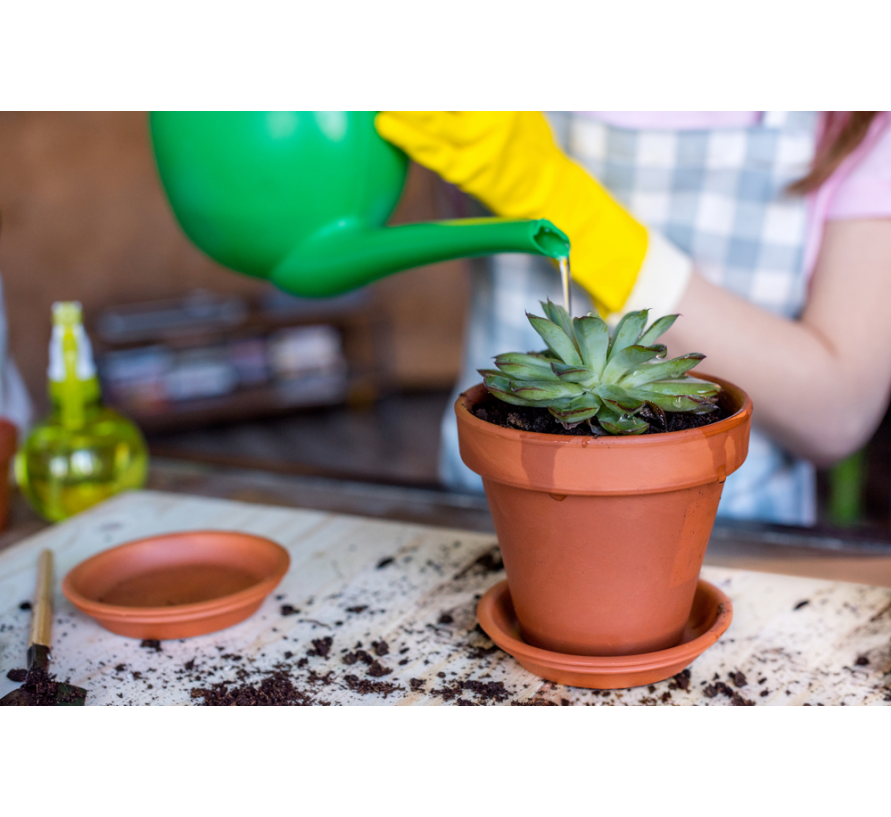¿Siempre se te va la mano al regar tus suculentas? Cómo hacerlo de la forma adecuada
Not sure how to look at your succulents and cacti the right way? Follow the advice we give you in this post
It sounds incredible, but most plants are more sensitive to excess water than to drought.
And succulents are the clearest example.
These hardy plants are all-rounders, capable of surviving just about anything.
Most succulents and cacti love to spend hours in full sun, have few pests, and are able to withstand many dry days. But if you water them more than necessary... prepare for them to get sick and withered.
That is what we want to avoid with this post.
Here, we are going to tell you everything you need to know to water your succulents properly:
- How often to water them and how to do it.
- Some useful tips so that excess water is never a problem.
Read it very carefully, because your succulents are going to thank you (a lot!)
How to water succulents and cacti: tips to give them the exact amount of water they need
The reality is that watering your succulents correctly isn't much of a mystery. But there are a number of details that you must take into account.
Take note.
1. Water until the soil is moist
Many people believe that the best option is to use a sprayer. They think that this way the plant suffers less because the land does not flood.
But is not so exactly.
Think about it: how do succulents that live in nature get water?
Normally it is through periods short but very intense. At those times, the water soaks into the soil, and the roots have time to absorb it and store it in the leaves to have reserves until the next rains.
Well, at home we must imitate that phenomenon.
The idea is to water abundantly until the entire pot substrate remains moist (beware, moist but not waterlogged; that can be harmful to the plant and favour the appearance of fungi).
It is better if you can do it with a watering can, because that way the irrigation will be more similar to natural rain.
Add water little by little until you see that the soil can no longer absorb any more water. And do not worry if a few drops fall on the leaves of the succulent, because that will not affect it negatively.
2. Let the soil dry out before watering again
This is where the key is.
A succulent can handle a moist substrate…as long as it's not too often.
Once you've watered, let the soil dry out completely again. Not a single drop of water left.
The simplest thing is to use a wooden stick and plunge it into the soil of the pot:
- If the end of the stick comes out wet or with traces of soil, it is that the pot still has water, and you will have to wait a little longer.
- But if it comes out completely dry and almost clean, then it's time to water again.
You may think that this is dangerous and that the succulent is going to dry out, but it is the other way around.
These plants are used to withstand drought, and therefore store the water they receive in the leaves. Although the soil where they are planted is dry, they can withstand a few more days without water (on the other hand, having the substrate always wet would damage their roots).
In addition, periods of drought cause the root system to develop. And the longer and thicker the roots of a plant, the better it uses water and the more resistant it becomes to new droughts.
Most succulents thrive on just one watering a week (or two, if it's summer and/or it's very hot in your area).
3. Pay attention to the drainage of the pot
This is another very important point.
Sometimes it's hard to gauge when the potting soil has received enough water, and it's easy to overdo it a bit.
In these cases, it is essential that the drainage is good.
A widely used trick is to put small balls of clay or pine bark at the bottom of the pot. In this way, the excess water will filter and come out through the hole in the base of the pot, avoiding puddles.
But in addition to that, it is also important that you use a substrate that does not retain too much water.
This has a lot to do with the next point.
4. Use a specific substrate for succulents
Succulents are used to living in terrain with very specific conditions. They are usually granular and dry land, even with sand.
Therefore, the ideal way to imitate their natural habitat and make our plants feel at home is to use a specific substrate for succulents, cacti and succulents.
This type of substrate is frequently made up of a mixture of clay, peat and sand, to provide the plant with optimal drainage and all the nutrients it needs to grow.
You already know how to water your succulents and cacti.
We hope these tips have been useful to you.
Remember that gardening is not an exact science and that each plant has specific needs.
That's why, even if it's a succulent, it's important to find out about its specific watering needs (there are some that come from tropical climates, for example, and need water on a more regular basis than their desert cousins).
If you require help with this, we can help you.
At Viveros González we have been working with our clients for more than 40 years to help them maintain a healthy garden and happy plants.
You just have to contact us here and tell us about your case so that we can advise.

 English
English Spanish
Spanish
Comments
Leave your comment